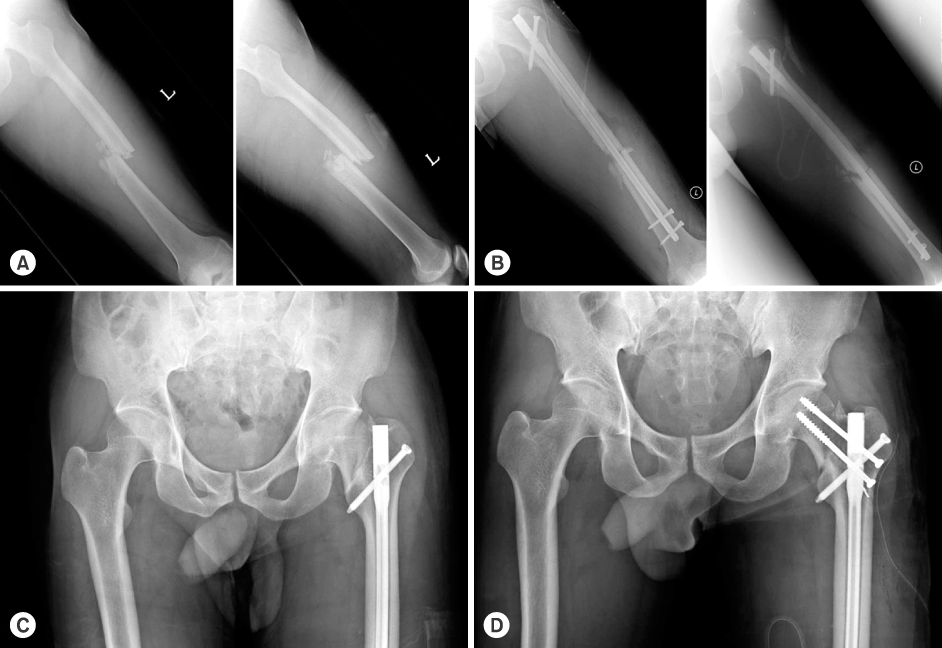J Korean Fract Soc.
2014 Apr;27(2):113-119. 10.12671/jkfs.2014.27.2.113.
Missed Fractures in Severely Injured Patients
- Affiliations
-
- 1Department of Orthopedic Surgery, Dankook University Hospital, Dankook University Medical College, Cheonan, Korea. idbabe@naver.com
- KMID: 1703109
- DOI: http://doi.org/10.12671/jkfs.2014.27.2.113
Abstract
- PURPOSE
The purpose of this study is to analyze anatomic distributions, diagnostic methods, and prognosis of missed fractures in patients with severe injury.
MATERIALS AND METHODS
A review of single-institutional medical records between January 2001 and May 2012 identified 58 patients with 62 delayed diagnoses of fractures among 4,643 severely injured patients older than 20 years with Injury Severity Scores higher than 16. We evaluated combined injuries, location of fractures, diagnostic methods, and reasons for missed diagnosis at initial exam.
RESULTS
Among 62 missed fractures, there were eight cases of spine fracture, 10 cases of peri-shoulder joint fracture, eight cases of upper extremity fracture, 10 cases of pelvis of acetabulum fracture, and 26 cases of lower extremity fracture. Head injury was the most common concomitant injury (23 cases). Initially missed fractures were most commonly discovered by official reading by radiologists. The most common reasons for misdiagnosis were the use of improper radiologic study and missed-reading of proper radiologic studies.
CONCLUSION
In order to prevent misdiagnosis of fractures in patients with severe injury, meticulous physical examination with suspicion of fractures should come first. In addition, obtaining proper radiologic study and thorough evaluation of radiologic images are important to decreasing the rates of missed fracture diagnoses. In addition, thorough surveillance for ipsilateral fractures is important in extremities with identified fractures.
Keyword
MeSH Terms
Figure
Cited by 1 articles
-
Neglected upper-extremity fractures at a severe trauma center in the Republic of Korea
Dong Hee Kim, Seung Soo Han, Sang Hyun Lee
Arch Hand Microsurg. 2023;28(4):233-238. doi: 10.12790/ahm.23.0034.
Reference
-
1. Richmond J, Egol KA, Koval KJ. Management of orthopaedic injuries in polytrauma patients. Bull Hosp Jt Dis. 2001-2002; 60:162–167.2. Houshian S, Larsen MS, Holm C. Missed injuries in a level I trauma center. J Trauma. 2002; 52:715–719.
Article3. Janjua KJ, Sugrue M, Deane SA. Prospective evaluation of early missed injuries and the role of tertiary trauma survey. J Trauma. 1998; 44:1000–1006. discussion 1006-1007.
Article4. Kalemoglu M, Demirbas S, Akin ML, et al. Missed injuries in military patients with major trauma: original study. Mil Med. 2006; 171:598–602.
Article5. Pfeifer R, Pape HC. Missed injuries in trauma patients: a literature review. Patient Saf Surg. 2008; 2:20.
Article6. Born CT, Ross SE, Iannacone WM, Schwab CW, DeLong WG. Delayed identification of skeletal injury in multisystem trauma: the 'missed' fracture. J Trauma. 1989; 29:1643–1646.7. Laasonen EM, Kivioja A. Delayed diagnosis of extremity injuries in patients with multiple injuries. J Trauma. 1991; 31:257–260.
Article8. Guly HR. Missed diagnoses in an accident & emergency department. Injury. 1984; 15:403–406.
Article9. Berlin L. Defending the "missed" radiographic diagnosis. AJR Am J Roentgenol. 2001; 176:317–322.
Article10. Wei CJ, Tsai WC, Tiu CM, Wu HT, Chiou HJ, Chang CY. Systematic analysis of missed extremity fractures in emergency radiology. Acta Radiol. 2006; 47:710–717.
Article11. Irving MH, Irving PM. Associated injuries in head injured patients. J Trauma. 1967; 7:500–511.
Article12. McLaren CA, Robertson C, Little K. Missed orthopaedic injuries in the resuscitation room. J R Coll Surg Edinb. 1983; 28:399–401.13. Juhl M, Møller-Madsen B, Jensen J. Missed injuries in an orthopaedic department. Injury. 1990; 21:110–112.
Article14. Williams SM, Connelly DJ, Wadsworth S, Wilson DJ. Radiological review of accident and emergency radiographs: a 1-year audit. Clin Radiol. 2000; 55:861–865.
Article15. Blackmore CC, Mann FA, Wilson AJ. Helical CT in the primary trauma evaluation of the cervical spine: an evidence-based approach. Skeletal Radiol. 2000; 29:632–639.
Article16. Herzog C, Ahle H, Mack MG, et al. Traumatic injuries of the pelvis and thoracic and lumbar spine: does thin-slice multidetector-row CT increase diagnostic accuracy? Eur Radiol. 2004; 14:1751–1760.
Article17. Watson JT, Moed BR. Ipsilateral femoral neck and shaft fractures: complications and their treatment. Clin Orthop Relat Res. 2002; (399):78–86.18. Wolinsky PR, Johnson KD. Ipsilateral femoral neck and shaft fractures. Clin Orthop Relat Res. 1995; (318):81–90.
- Full Text Links
- Actions
-
Cited
- CITED
-
- Close
- Share
- Similar articles
-
- Analysis of Missed Fractures by Bone Scan in Elderly Hip Fracture Patients with Osteoporosis
- Analysis of Missed Fractures in Polytrauma Patients
- A Cause Analysis of Missed Fractures in an Emergency Medical Center
- Incidence and Prevention of Venous Thromboembolism in Severely Injured Patients with Lower Extremity Fracture
- Neglected upper-extremity fractures at a severe trauma center in the Republic of Korea



